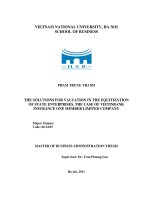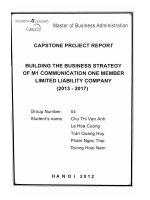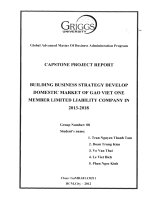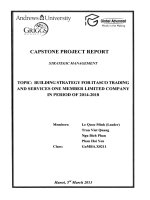26 FINANCIAL SITUATION OF HANOI CONSTRUCTION ASSOCIATION ONE MEMBER LIMITED COMPANY
Bạn đang xem bản rút gọn của tài liệu. Xem và tải ngay bản đầy đủ của tài liệu tại đây (1.05 MB, 132 trang )
MINISTRY OF FINANCE
ACADEMY OF FINANCE
*
BUI LINH TRANG
CQ55/11.02
GRADUATION THESIS
TOPIC:
“ FINANCIAL SITUATION OF HANOI CONSTRUCTION
ASSOCIATION ONE MEMBER LIMITED COMPANY”
Major
: Corporate Finance
Student ID : 17523402010820
Supervisor
: PhD. Ngo Thi Kim Hoa
Ha Noi - 2021
ACADEMY OF FINANCE
GRADUATION THESIS
DECLARATION
I hereby declare that this thesis is my own work and effort. It has not been
submitted anywhere for an award. Where other sources of information have been
used, they have been acknowledged.
Graduation thesis author
Bui Linh Trang
BUI LINH TRANG
i
CQ55/11.02
ACADEMY OF FINANCE
GRADUATION THESIS
ACKNOWLEDGEMENT
I would like to take this opportunity to express my deepest gratitude and
appreciation to the people who have given me their assistance throughout my
studies during the preparation of this thesis. They are my teachers, my colleagues,
my family and my friends. I would like to express my great thanks to all of them.
First of all, I would especially like to thank my advisor, PhD. Ngo Thi Kim
Hoa , for her continuous encouragement and especially for her academic and
creative guidance. She has been my source for inspiration throughout my thesis.
Without her support, I would not be able to complete my thesis. And I really
appreciate her patience in reading and correcting my thesis.
Secondly, I am indebted to all my teachers at Academy of Finance for their
guidance and help with valuable lessons throughout four years of study.
Moreover, I would like to thank especially chief accountant, and the staffs of
Hanoi Construction Association One Member Limited Company, for their valuable
supports during the internship period. Without their helps, it would be impossible
for me to finish this work.
Last but not least, many thanks to my family, friends and classmates for their
great love and care in both spirit and health during preparation for the
undergraduate thesis.
BUI LINH TRANG
ii
CQ55/11.02
ACADEMY OF FINANCE
GRADUATION THESIS
ABSTRACT
This study investigated the factual state of financial efficiency at Hanoi
Construction Association One Member Limited Company from the viewpoint of a
fourth year student of Faculty of Corporate Finance, Academy of Finance. The
paper aims at finding out the drawbacks in the company’s financial and the reasons,
and more importantly suggesting main methods to improve the efficiency of
financial in the company. In achieving these aims, the graduation paper surveys the
current situation of financial and assess that whether it is effective or not. From
received results, the study argues the most practical implications at Hanoi
Construction Association One Member Limited Company to improve the efficiency
of financial of the company in the year to come.
BUI LINH TRANG
iii
CQ55/11.02
ACADEMY OF FINANCE
GRADUATION THESIS
DECLARATION.................................................................................................................i
ACKNOWLEDGEMENT....................................................................................................ii
ABSTRACT.....................................................................................................................iii
LIST OF ABBREVIATIONS.................................................................................................v
CHAPTER I.....................................................................................................................5
1.1.2 Corporate financial management................................................................................................. 7
1.1.2.2. The role of corporate financial management............................................................................7
1.2.2.5 Liquidity and Solvency............................................................................................................. 28
1.2.2.7 The situation of profit distribution of the business..................................................................37
CHAPTER II:..................................................................................................................41
THE FINANCIAL SITUATION OF HANOI CONSTRUCTION ASSOCIATION ONE MEMBER
LIMITED LIABILITY COMPANY........................................................................................41
2.1.2.1 Function and business lines of the company............................................................................43
2.1.2.2 Business performance characteristics of the company................................................................2
2.1.2.3 The advantages and disadvantages in the process of operations of the company......................5
2.2. The financial situation of Hanoi Construction Association One Member Limited Company
.................................................................................................................................................6
2.2.1. The company’s assets and Assets structure....................................................................6
2.2.2 The company’s Capital and Capital structure.................................................................12
2.2.3 The company’s Revenues, Expenses and Income........................................................................22
2.2.4 The company’s Cash flow situation............................................................................................. 27
2.2.5 The company’s Liquidity and solvency:....................................................................................... 31
2.2.6 The company’s asset utilization efficiency................................................................................... 39
2.2.7 The company’s profit distribution............................................................................................... 47
3.1.1.1. World socio-economic context............................................................................................... 51
3.1.1.2. Vietnam's socio-economic context......................................................................................... 52
3.1.2.1. The company's development goals and orientations in the coming time................................58
3.1.2.2. The targets of production and business plan in 2021..............................................................59
3.3.1. On the business side.................................................................................................................. 75
BUI LINH TRANG
iv
CQ55/11.02
ACADEMY OF FINANCE
GRADUATION THESIS
LIST OF ABBREVIATIONS
BEP
Basic Earnings Power
CA
Current Assets
CL
Current Liabilities
EBIT
Earnings Before Interest and Tax
EBT
Earnings Before and Tax
ROA
Return on Assets
ROE
Return on Equity
NI
Net income
NWC
Net working capital
ROS
Return on Sales
VND
Viet Nam dong
LIST OF TABLES
Table 2.2: Analysis of the size and structure of assets in 2020.........................................6
Table 2.3: Analysis of structure capital in 2020..............................................................12
Table 2.4: Analysis of capital size and structure in 2020................................................14
Table 2.5 Analysis of the funding model........................................................................20
Table 2.6: Analysis of business performance and results in 2020...................................22
Table 2.7: Analysis of Business operation of the company in 2019-2020........................24
Table 2.8 Ratio of money generation of the enterprise..................................................27
Table 2.9 Fluctuations in Receivable and To pay debt of company.................................32
Table 2.10: Liquidity and Solvency analysis in 2020.......................................................36
Table 2.11: Performance analysis in 2020.....................................................................40
Table 2.12: Analysis of profitability of companies in 2020.............................................44
Table 2.12: Estimated implementation of some major targets in the 2016-2020............54
BUI LINH TRANG
v
CQ55/11.02
ACADEMY OF FINANCE
GRADUATION THESIS
(Source: Report on the implementation of socio-economic development plans for 2020
and 5 years 2016-2020; Expected plans for 2021 and directions and tasks for 5 years
2021-2025)...................................................................................................................54
Table 3.1: The main targets of the plan for the year 2021.............................................59
BUI LINH TRANG
vi
CQ55/11.02
ACADEMY OF FINANCE
GRADUATION THESIS
LIST OF FIGURES
Figure 1.1: Company funding model.............................................................................20
Figure 2.1: Organizational structure operating of the company....................................43
Figure 2.2: The company's accounting system.................................................................2
Figure 2.3: Fluctuations in capital assets in 2019 - 2020..................................................7
Figure 2.4: Fluctuations in capital structure of company in 2019 - 2020.........................16
Figure 2.5: Receivable and Payable fluctuations trends of company in 31/12/2019 and
31/12/2020..................................................................................................................34
BUI LINH TRANG
vii
CQ55/11.02
ACADEMY OF FINANCE
GRADUATION THESIS
PREFACE
1. Research background
Currently, the deep changes of the world economy as well as the
domestic economy have posed many difficulties and challenges for businesses,
making the competition among economic sectors more and more. should be
harsh. Besides, globalization has become an inevitable trend of the world
economy, Vietnam is not out of that inevitable trend. Globalization has opened
up new opportunities for businesses and organizations, but it means that
businesses are facing many new challenges with increasingly fierce competition
from the market economy. . Enterprises not only compete with enterprises in the
same industry and field but also have to compete with many competitors with
strong financial potential both at home and abroad.
In this situation, the urgent requirement for managers is how to build and
maintain a competitive advantage, thereby helping their businesses survive and
develop sustainably. This has forced businesses not only to rise up in the
process of production and business but also to know how to maximize their
potential to achieve the highest business efficiency. From these practical
requirements, enterprises need to understand the results of their business
activities and their financial status in each period in order to make appropriate
decisions to minimize risks in activities, especially especially in financial
management as well as orientation for the development of the entire enterprise
in the future. To do so, the financial managers must evaluate and analyze the
business activities as well as the financial activities of the enterprises on a
regular basis in detail and efficiency.
Recognizing the importance of analyzing the financial situation and
assessing the financial status of a business, I have researched, researched and
selected to implement the topic: “ Financial stituation of Hanoi Construction
Association One Member Limited Company ”
BUI LINH TRANG
1
CQ55/11.02
ACADEMY OF FINANCE
GRADUATION THESIS
2. Research purpose
The research of fnancial situation and solutions to improve the financial
situation implemented at Hanoi Construction Association One Member Limited
Company has the following purposes:
- Proposing a number of major solutions to contribute to improving the
financial situation in the future
At the same time, set out a number of tasks:
- Systematize the theoretical issues of corporate finance and analyze the
corporate financial situation
- Find out the current financial situation of the company in 2020 on the basis of
comparison with 2019
-From the assessment of the current situation of the business to propose a
number of major solutions to contribute to improving the financial situation in
the future.
- Research subjects: Financial situation of Hanoi Construction Association One
Member Limited Liability Company.
3. Scope of study
- Research on the financial situation of Hanoi Construction Association One
Member Limited Liability Company in the period 2019-2020
- Figures are taken from accounting book, financial statements in 2019,2020
4. Methodology and Data
4.1. The method of data collection
Through collecting an overview of the internship unit from relevant
departments, the intern's financial statements over the years 2019 and 2020;
current legal documents related to research issues; publications, books and
newspapers inside and outside the Academy ...
4.2 Methods of data analysis
From the collected data, to have the appropriate information to complete
the final thesis, the methods used are:
BUI LINH TRANG
2
CQ55/11.02
ACADEMY OF FINANCE
•
GRADUATION THESIS
Evaluation methods: including techniques: comparison, division, correlation
relationship, ranking, graph, ...
•
Factor analysis method: includes methods: continuous replacement, number
difference, balance, analysis of the nature of the factors
•
Prediction method: is the corporate financial analysis method used to
forecast corporate finance, including the following main methods: probability
calculation method, sensitivity analysis, regression, linear planning, using
model econometric.
5. Literature review
Regarding analyzing the financial situation of enterprises, there are many
researches including topics such as:
- Thesis “The financial situation of Kinh Do Joint Stock Company" by Vu
Thi Bich Ha- Hanoi National University in 2012. In which, the author has
analyzed the current financial situation at Kinh Do Joint Stock Company by
general analysis and analysis of groups of financial ratios. In the thesis, the
group of market value coefficients and the Z-score model are used in the
analysis.
- Thesis "The financial situation at Vinaconex Joint Stock Company" in 2013
by Bui Van Lam. Based on many analytical methods such as comparison, detail
that determines the impact of the coefficients on the company's finances. Since
then, it has proposed to propose the award to contribute to perfecting the
analysis of the financial situation to serve the needs of financial management,
production and business to meet the requirements of the market.
- Thesis "Financial situation at Construction and Infrastructure Development
Joint Stock Company No. 18" in 2015 by Hoang Duc Anh - Academy of
Finance. The main structure of the thesis is analysis of the current situation. on
the financial situation and analyzing financial indicators to propose solutions to
improve the efficiency of capital use, the efficiency of financial management of
the Company, thereby knowing strengths and weaknesses. and solutions to
overcome.
- Thesis "Financial situation at Vinaconex 25 Joint Stock Company", 2016 by
author Bui Van Lam - University of Da Nang. The thesis contributes to
systematizing theories about analyzing the financial situation. At the same time,
BUI LINH TRANG
3
CQ55/11.02
ACADEMY OF FINANCE
GRADUATION THESIS
from assessing the current situation of analyzing the financial situation to create
a company, the sis has come up with a solution to complete the financial
analysis of Vinaconex 25 Joint Stock Company.
- Thesis "The financial situation at Binh Minh Import - Export Investment
Joint Stock Company" by Chu Hong Anh - Academy of Finance. The thesis
presents basic theoretical basis, analyzes the current situation and recommends
solutions to improve the financial performance of the company.
Through analyzing theses on the financial situation of the enterprises
mentioned above, the author has a deeper insight into the process of analyzing
the financial situation of an enterprise. Understand the method of analyzing the
financial situation. However, in the studies on this topic, there is no research on
the financial situation of the one member limited liability company of Hanoi
Construction Association. Therefore, the thesis has focused on researching the
financial situation of the company to offer solutions to improve financial
efficiency in this business.
6. Thesis structure:
Chapter 1: Overview of financial situation of a company
Chapter 2: The financial situation of Hanoi Construction Association One
Member Limited Liability Company.
Chapter 3: Solutions to improve the financial situation of Hanoi Construction
Association One Member Limited Liability Company.
Due to the limited knowledge as well as pratical experience, the
limitations and shortcomings in my article cannot be ignored. I look forward to
receiving the suggestions from the company and the teachers in the Corporate
Finance subject to make my final thesis more complete.
Hanoi, May 2021
The author of thesis
Bui Linh Trang
BUI LINH TRANG
4
CQ55/11.02
ACADEMY OF FINANCE
GRADUATION THESIS
CHAPTER I
OVERVIEW OF FINANCIAL SITUATION OF A COMPANY
1.1. Corporate finance and corporate financial management
1.1.1. Corporate finance and corporate finance decisions
1.1.1.1. Definition of corporate finance
The textbook of Corporate Finance of the Academy of Finance published in
2015 states that:
In essence, corporate finance is the economic relationship in the form of value
arising associated with the creation and use of monetary funds of an enterprise
during the operation of the business.
In terms of form, corporate finance are monetary funds in the process of
creating, distributing, using and mobilizing associated with enterprise operations.
Thus, it can be understood, the superficial manifestation of corporate finance
is the cash flows arising in the process of creating and using monetary funds
associated with the enterprise's operations. However, the internal content of those
cash flows is economic relations in the form of value between enterprises and
entities in the distribution of financial resources.
1.1.1.2 Financial decisions of the company
Although not completely unified in the concept of corporate finance in terms
of language; However, there is a consensus when different conceptions about
corporate finance are that: corporate finance is actually interested in studying three
main decisions, which are investment decisions, capital decisions and decide to
distribute profits.
+ Investment decision: are decisions related to the total value of assets and the
value of each part of assets (fixed assets and liquid assets). The investment decision
affects the left side (the assets part of the balance sheet). Major investment
decisions of a company include:
BUI LINH TRANG
5
CQ55/11.02
ACADEMY OF FINANCE
GRADUATION THESIS
- Decisions on investment in liquid assets: decisions on inventory, decisions on
inventory, decisions on sales policies, decisions on short-term financial investments
- Decision on investment in fixed assets: decision to purchase fixed assets, decide
on project investment, decide on long-term financial investment ...
- Deciding on the structural relationship between investment in liquid assets and
investment in fixed assets: Deciding to use leverage and deciding break-even point.
Investment decision is considered the most important decision in corporate
finance because it creates value for the business. A correct investment decision will
contribute to increasing the value of the business, thereby increasing the value of
assets for the owner, otherwise a wrong investment decision will damage the value
of the business, leading to damage. property for business owners.
+ Financing decision : are decisions related to choosing which source of capital to
provide for investment decisions. Capital decisions affect the right side of the
balance sheet (capital portion). Major capital raising decisions of businesses
include:
- Decision to mobilize short-term capital: decision to borrow short-term or use
commercial credit.
- Long-term capital mobilization decision: Decision to use long-term debt through
long-term bank loans or corporate bonds; decision to issue share capital (common
shares or preferred shares); decide the structural relationship between debt and
equity (financial leverage); decide to borrow to buy or rent property, ...
To make the right financing decisions, financial managers must have a firm
grasp of the advantages and disadvantages of using capital mobilization tools;
accurately assess the current situation and properly forecast market movements future prices ... before making a decision to raise capital.
+ Dividend dicision: Attached to decisions about the dividend distribution or
dividend policy of the business. Financial managers will have to choose between
using the majority of their after-tax profits for dividends or withholding for
reinvestment. These decisions relate to how a firm should pursue a dividend policy
and whether the dividend policy affects the firm's value or the company's stock
price on the stock market. or not.
BUI LINH TRANG
6
CQ55/11.02
ACADEMY OF FINANCE
GRADUATION THESIS
1.1.2 Corporate financial management
1.1.2.1 Definition of financial mangement
Corporate financial management is the selection and making of financial
decisions, the organization implementing those decisions to achieve the financial
performance of the business, which is to maximize profits, continuously. increase
the enterprise value and the competitiveness of the business in the market.
1.1.2.2. The role of corporate financial management
The role of financial governance in business operations is reflected through
the following main aspects:
a) Raising capital to ensure the normal and continuous operation of the business:
Monetary capital is the money for the operations of the business. During the
operation of the business, there are often short-term and long-term capital
requirements for regular business activities, as well as for investment and
development of enterprises. Failure to promptly and adequately mobilize capital
will make business operations difficult or impossible. Therefore, ensuring business
activities are carried out normally and continuously depends greatly on the
organization of capital mobilization of corporate finance.
The enterprise's financial manager on the basis of considering the financial
market situation, capital needs and specific conditions of the business, then makes
the best decision in organizing the mobilization of capital sources (inside, outside)
to meet the needs of business activities. A proper sponsorship policy not only helps
businesses minimize financial risks but also has a great impact on the achievement
of the goal of maximizing business value.
b) Organizing the use of capital economically and effectively, contributing to
improving the efficiency of business operations of enterprises
BUI LINH TRANG
7
CQ55/11.02
ACADEMY OF FINANCE
GRADUATION THESIS
With the selection of optimal investment projects on the basis of consideration
and comparison between the rate of return, the cost of capital mobilization and the
level of risk of investment projects ... financial managers have created a premise for
the use of capital economically and effectively.
The timely and sufficient capital mobilization will help businesses take
advantage of business opportunities, increase revenue and business profits.
Choosing the right form and method of capital mobilization, ensuring the optimal
capital structure can help businesses reduce the cost of capital, contribute to
increasing profits and return on equity of enterprise.
On the other hand, with the maximum mobilization of existing capital in
business activities can help businesses avoid losses due to capital stagnation,
increase asset turnover, reduce the amount of loans, thereby reducing interest
payments. loans, contributing to increase the profit after tax of the business.
c) Comprehensively inspect and supervise all aspects of production and business
activities of the enterprise
The business operation process of an enterprise is also the process of
mobilizing and transforming monetary capital form. Therefore, by examining the
daily monetary revenues and expenditures, and especially through analyzing and
evaluating the financial position of the business and the implementation of financial
indicators, financial managers. can control in time and comprehensively all aspects
of business activities, thereby pointing out shortcomings, untapped potentials to
make appropriate decisions, adjusting activities to achieve title out of the business.
1.1.2.3 The contents of financial management in a company
Corporate financial management often includes the following main contents:
Participate in evaluation, selection, investment projects and business plans.
The construction and selection of investment projects are done jointly by many
parts of the business. From a financial perspective, the main thing to consider is the
BUI LINH TRANG
8
CQ55/11.02
ACADEMY OF FINANCE
GRADUATION THESIS
main financial efficiency that is to consider and weigh the costs, the risks that can
be encountered and the possibility of profitability, ability to carry out the project. In
the selection analysis, evaluation of optimal projects, projects with high
profitability, the financial manager is the one who considers how to use investment
capital; on the basis of participating in the evaluation and selection of investment
projects, it is necessary to find out the business development orientation, when
considering investing capital to implement investment projects, attention should be
paid to enhancing competitiveness. to ensure immediate and long-term economic
efficiency.
Determine capital needs, organize the mobilization of capital sources to meet
the operation of enterprises. All activities of the business require capital. Entering
into business operations, corporate financial management needs to determine the
essential capital needs for the operations of the business in the period. Working
capital includes long-term and short-term capital, and it is important to organize the
mobilization of capital to fully meet the operating needs of the business. The
mobilization of capital sources has a great influence on the performance of an
enterprise. In order to decide on the appropriate form and method of capital
mobilization, enterprises need to consider and consider in many aspects such as:
capital structure, costs for the use of capital sources, advantages and disadvantages.
benefits of capital mobilization.
To well organize the use of existing funds, strictly manage revenues and
expenditures, and ensure the solvency of the enterprise. Corporate financial
management must find ways to contribute to maximum mobilization of existing
capital in business operations, freeing up stagnant capital sources. Closely monitor
and implement well the sales and other revenues, strictly manage expenses arising
during the operation of the business. Find ways to restore the balance between
revenue and expenditure in money to ensure that businesses are always able to pay.
On the other hand, it is also necessary to clearly define the expenses in the business
of the enterprise, the taxes that the enterprise must pay, determine which expenses
BUI LINH TRANG
9
CQ55/11.02
ACADEMY OF FINANCE
GRADUATION THESIS
are the costs for the business operation and the expenses belonging to the other
activities.
Perform well the distribution of profits, setting up and using the funds of the
business. The proper distribution of profit after tax as well as appropriation and
good use of corporate funds will make an important contribution to the development
of the business and to improve the lives of employees. Profit is the goal of business
operation is an indicator that enterprises must pay special attention to because it is
related to the existence and expansion of the business. It cannot be said that a good
enterprise has high efficiency while operating profit is reduced. Enterprises need to
have optimal methods in distributing corporate profits. In determining the rate and
form of the enterprise's funds such as development investment fund, financial
reserve fund, bonus fund and welfare fund.
Ensure regular inspection and control over the business operations of the
business and perform well financial analysis. Through the situation of daily money
collection and spending, the implementation of financial indicators allows to
regularly check and control the operation of the business. On the other hand,
periodically need to conduct analysis of corporate financial situation. Financial
analysis to assess the strengths and weaknesses of the financial and business
performance of the business, thereby helping business leaders in overall assessment
of the performance of the business. enterprises, strengths and weaknesses in
business operations such as solvency, material rotation, capital, business
performance, from which right decisions can be made. in terms of production and
finance,
Perform well financial planning. The financial performance of the business
should be foreseen in advance through financial planning. Good implementation of
financial planning is an essential tool to help businesses proactively come up with
timely solutions when there are market fluctuations. The financial planning process
is also the appropriate financial decision-making process to achieve the business
goals.
1.2. The financial situation of a company
BUI LINH TRANG
10
CQ55/11.02
ACADEMY OF FINANCE
GRADUATION THESIS
1.2.1. Definition of financial situation of a company
a) Definition of financial situation of a compay
Assessment of corporate financial situation is a combination of methods that
allow assessing the past and present financial situation, predicting the future
financial situation of the business, helping managers to make the Effective
management decisions, consistent with the goals they care about.
b) Objective of corporate financial assessment
The goal of assessing the financial position of a business is different for each
audience. Specifically:
- For business managers: need information about the financial situation of the
business to control and direct the business and production situation of the business,
to orient decisions on investment and structuring financial resources, distributing
profits, assessing business performance to take measures to adjust accordingly,
implementing financial balance, profitability, solvency and forecasting risks Risk
risk, especially financial risk signals in the business, from which to make financial
forecasts and plans and appropriate financial decisions, to easily conduct inspection
and control. management in the business.
- For investors: need information about the financial assessment of the business to
clarify the development prospects of the business, estimate the value of shares on
the financial market to make a major investment decision. corpses bring high profits
in the future.
- For lenders: for short-term loans, the lender is interested in counting the
immediate solvency of the business (also known as the enterprise's ability to
respond to the maturity of the loan); For long-term loans, lenders are concerned
with the profitability of borrowed capital, invested capital and factors causing
payment risks and long-term financial risks to determine their repayment capacity.
pay capital and interest and make loan decisions.
BUI LINH TRANG
11
CQ55/11.02
ACADEMY OF FINANCE
GRADUATION THESIS
- For people with salary in the business: the benefits of this group of people are the
income and promotion opportunities that the business gives them, so assessing their
financial situation helps them orient their jobs and invest. finance for the future.
- For state management agencies: State management agencies (tax agencies,
financial inspection agencies, Statistics ...) use the results of corporate financial
assessment to inspect and supervise the business performance of enterprises in the
economy, thereby proposing policies, management mechanisms and financial
solutions suitable to the actual situation of the business, creating Favorable legal
corridor environment contributes to helping enterprises improve production and
business efficiency.
Thus, assessing the financial position of the business is a useful management
tool that helps to provide information to management entities, as a basis for making
useful management decisions to preserve and increase. your interests at the business.
c) The sequence of steps to conduct corporate financial analysis
To accurately analyze corporate financial situation, analysts need to follow 3
main steps: Information gathering, information processing, prediction and decision.
- Collect information:Financial analysis uses all sources of information
capable of explaining and disclosing the current financial status of the business,
serving the financial prediction process. It includes inside information to outside
information, of which accounting information is concentrated in the corporate
financial statements are particularly important sources of information.
- Information processing:Information collected must be handled in a
systematic and scientific manner. Depending on different analytical objectives,
information users have analytical angles and apply different analytical methods to
calculate, compare, explain, evaluate, and determine the cause for the process.
process prediction and decision-making.
- Prediction and decision making:It can be said that the goal of financial
analysis is to make financial decisions. For business owners, financial analysis aims
BUI LINH TRANG
12
CQ55/11.02
ACADEMY OF FINANCE
GRADUATION THESIS
to make decisions related to the business goals of growing, developing, and
maximizing business value. For lenders and investing in a business, it's about
making financing and investment decisions, ...
d) The sequence of steps to conduct corporate financial analysis
To accurately analyze corporate financial situation, analysts need to follow 3 main
steps: Information gathering, information processing, prediction and decision.
Collect information:Financial analysis uses all sources of information
capable of explaining and disclosing the current financial status of the business,
serving the financial prediction process. It includes inside information to outside
information, of which accounting information is concentrated in the corporate
financial statements are particularly important sources of information.
Information processing:Information collected must be handled in a
systematic and scientific manner. Depending on different analytical objectives,
information users have analytical angles and apply different analytical methods to
calculate, compare, explain, evaluate, and determine the cause for the process.
process prediction and decision-making.
Prediction and decision making:It can be said that the goal of financial
analysis is to make financial decisions. For business owners, financial analysis aims
to make decisions related to the business goals of growing, developing, and
maximizing business value. For lenders and investing in a business, it's about
making financing and investment decisions, ...
e) Documents used in corporate financial analysis
In order to be able to accurately and comprehensively assess an enterprise's
financial position, analysts need to use a combination of documents including
external and internal documents:
* Documents outside the enterprise: are financial ratios, industry averages,
legal documents prescribing the accounting regime, management regime for each
business line.
* Internal corporate documents: are quarterly and annual financial
statements, detailed accounting books that track accounts, business plans for each
period of the company. In which the main and most important documents are the
financial statements of the unit. Specifically
BUI LINH TRANG
13
CQ55/11.02
ACADEMY OF FINANCE
GRADUATION THESIS
Accounting balance sheet: is the main financial statement, which generally
reflects the entire situation of assets and sources of asset formation at a given time.
Reporting business results: means a general financial report, generally
reflecting the situation and results of business activities in an accounting period of
the enterprise in details for each production and business activity (sales and service
provision; activities). financial activities and other activities).
Statements of cash flows: is an integral part of the corporate financial
reporting system, providing information to help users evaluate changes in net assets,
financial structure, ability to convert assets into money, liquidity and the ability to
generate cash flows during the operation.
Notes to the financial statements: is a detailed explanation of some general
indicators reflected in other financial statements and at the same time a statement of
the applied corporate accounting policies to record economic transactions arising in
the enterprise. The report reader has additional information necessary for evaluating
the financial position of the business
The above documents are the basis for analysts to get data and information,
correctly determine the financial indicators of the business and make reasonable
comment
f) Analytical method
To analyze corporate finance, one can use one or a combination of different
methods in the corporate financial analysis methods system. Here, the writer would
like to present some basic methods as follows:
Evaluation method
The evaluation method is always used in corporate financial analysis, and is
also used in many stages of the analysis process. Usually when assessing people
often use the following techniques:
Comparative method:This is a widely used method in economic analysis in
general and financial analysis in particular. When using the comparison method, it
is necessary to pay attention to the problems of comparison conditions, the basis for
comparison and the commonly used comparison technique is absolute numerical
comparison, relative numerical comparison, vertical comparison, horizontal
comparison ...
BUI LINH TRANG
14
CQ55/11.02
ACADEMY OF FINANCE
GRADUATION THESIS
Method of division (details): This is a method of breaking down the financial
performance and process according to certain criteria to serve the purpose of
process awareness and that result under different aspects consistent with the target
of interest of each. subjects in each period.
Contact method for comparison and ranking:is an analytical method used to
study and evaluate research objects based on economic and financial relationships
of phenomena, processes and results of corporate financial operations with related
parties. The ranking of research subjects should be based on quantitative and
qualitative information that reflects the average basic financial characteristics of the
subjects of the same type, the main environmental impacts on research subjects.
Graphical method: visually reflect the analyzed data graphically, graph,
thereby describing trends, fluctuations level of research indicators or showing
structural relationships of parts in a whole. Graphical method includes many forms
such as bar graph, circle ... This method clearly, visually shows the increase or
decrease or the relationship between the indicators.
Factor analysis method
The method is used to set up the formula for calculating financial and economic
indicators in relation to the influencing factors, thereby determining the influence
level of each factor and analyzing the nature of the influence. of factors to analytical
criteria.
• The method of determining the influence of the factors:is the method used to
determine the specific influence of each factor on the research criteria. The
commonly used methods to determine the influence of the factors are: the consensus
substitution method (used when the analytical indicator is related to the influencing
factor, expressed in the form of an injury or injury equation. ), the difference
number method (the consequence of the continuous substitution method applied on
the basis of complying with the order of factors), the balance method (applied when
analytical criteria are related to multiplication influence factor as sum or
difference).
• Methods of analyzing the properties of the factors:implementation after
determining the influence of factors, in order to evaluate and reasonably predict, on
BUI LINH TRANG
15
CQ55/11.02
ACADEMY OF FINANCE
GRADUATION THESIS
which basis to make decisions and how to implement those decisions. The analysis
must specify the influence level, determine the subjective and objective properties
of each influencing factor, evaluate specific predictions and determine the
significance of the factors affecting the researched indicator. , consider.
Method of forecasting
Is the corporate financial analysis method used to forecast corporate finances. There
are many different methods to forecast economic and financial indicators, but often
people use the following methods: probability calculation method, sensitivity
analysis, regression method, linear planning method, method using econometric
model ...
BUI LINH TRANG
16
CQ55/11.02









